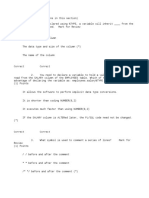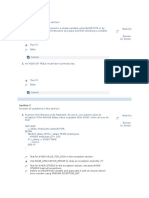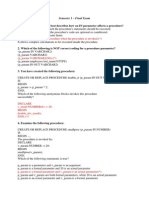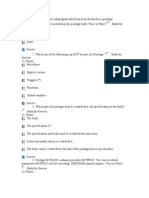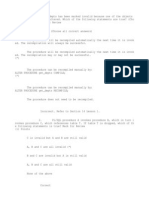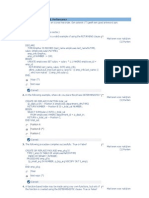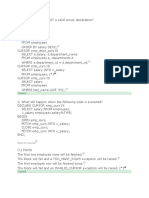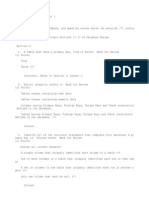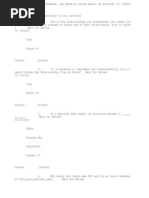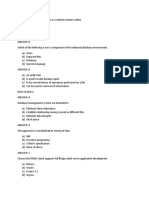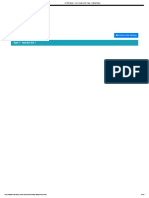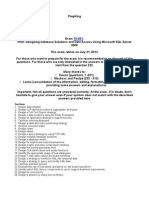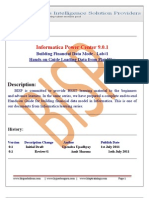Section 6
Section 6
Uploaded by
SebassssdCopyright:
Available Formats
Section 6
Section 6
Uploaded by
SebassssdOriginal Description:
Copyright
Available Formats
Share this document
Did you find this document useful?
Is this content inappropriate?
Copyright:
Available Formats
Section 6
Section 6
Uploaded by
SebassssdCopyright:
Available Formats
Test: Quiz: User-Defined Records Review your answers, feedback, and question scores below.
An asterisk (*) indicates a correct answer. Section 1 (Answer all questions in this section) 1. Which of the following statements about user-defined PL/SQL records is NOT true? Mark for Review (1) Points
It is not the same as a row in a database table It can be used as an OUT parameter in a package procedure It can be a component of another PL/SQL record It must contain one or more components, but all the components must have scalar datatypes (*) It can be defined as NOT NULL Correct 2. The following code declares a PL/SQL record with the same structure as a row of the departments table. True or False? DECLARE v_dept_rec departments%ROWTYPE; ... True (*) False Correct 3. Which of the following will successfully create a record type containing two fields, and a record variable of that type? TYPE person_type IS RECORD (l_name VARCHAR2(20), gender CHAR(1)); person_rec TYPE person_type; TYPE person_type IS RECORD (l_name VARCHAR2(20), gender CHAR(1)); person_rec person_type; (*) TYPE person_type IS (l_name VARCHAR2(20), gender CHAR(1)); person_rec person_type; TYPE person_type IS (l_name VARCHAR2(20), gender CHAR(1)); person_rec TYPE person_type; Correct Test: Quiz: Indexing Tables of Records Review your answers, feedback, and question scores below. An asterisk (*) indicates a correct answer. Mark for Review (1) Points Mark for Review (1) Points
Section 1 (Answer all questions in this section) 1. Which of these PL/SQL data structures can NOT store a collection? Mark for Review (1) Points
A PL/SQL record (*) An INDEX BY table of records An INDEX BY table indexed by PLS_INTEGER An INDEX BY table indexed by BINARY_INTEGER Correct 2. Which of the following successfully declares an INDEX BY table of records which could be used to store copies of complete rows from the departments table? DECLARE TYPE t_depttab IS TABLE OF departments%TYPE INDEX BY BINARY_INTEGER; DECLARE TYPE t_depttab IS TABLE OF departments%ROWTYPE INDEX BY BINARY_INTEGER; (*) DECLARE TYPE t_depttab IS INDEX BY TABLE OF departments%ROWTYPE INDEX BY BINARY_INTEGER; DECLARE TYPE t_depttab IS TABLE OF departments%ROWTYPE INDEX BY NUMBER; Correct 3. Which of the following methods can be used to reference elements of an INDEX BY table? (Choose three.) (Choose all correct answers) EXISTS (*) FIRST (*) COUNT (*) PREVIOUS DROP Correct 4. Which of these PL/SQL data structures could store a complete copy of the employees table, i.e., 20 complete table rows? A record Mark for Review (1) Points Mark for Review (1) Points Mark for Review (1) Points
An INDEX BY table of records (*) An INDEX BY table An explicit cursor based on SELECT * FROM employees; Incorrect. Refer to Section 6 Lesson 2. 5. What is the largest number of elements (i.e., records) that an INDEX BY table of records can contain? 100 4096 32767 Many millions of records because a BINARY_INTEGER or PLS_INTEGER can have a very large value (*) None of the above Correct 6. To declare an INDEX BY table, we must first declare a type and then declare a collection variable of that type. True or False? True (*) False Correct Mark for Review (1) Points Mark for Review (1) Points
You might also like
- Oracle Database Design Final ExamDocument15 pagesOracle Database Design Final ExamUnnamed100% (7)
- Oracle DBA QueriesDocument27 pagesOracle DBA QueriesSajeev K Puthiyedath100% (1)
- Midterm Part 2Document19 pagesMidterm Part 2alexpuiuNo ratings yet
- 1 FinalDocument17 pages1 FinalAlexandra LajtrikNo ratings yet
- Quiz 10Document7 pagesQuiz 10AndriyNo ratings yet
- Oracle E-Business Suite Manufacturing & Supply Chain ManagementFrom EverandOracle E-Business Suite Manufacturing & Supply Chain ManagementNo ratings yet
- Section 6 Quiz PLSQLDocument4 pagesSection 6 Quiz PLSQLOvie Widiyastuti80% (5)
- Section 5Document16 pagesSection 5Sebassssd33% (3)
- Informix TuningDocument29 pagesInformix TuningMarouani AmorNo ratings yet
- E TRMDocument7 pagesE TRMtsurendarNo ratings yet
- PLSQL Oracle Teste CopieDocument143 pagesPLSQL Oracle Teste CopiedraufyNo ratings yet
- PLSQL Oracle Mid Term Exam Semester 1 Part 1Document21 pagesPLSQL Oracle Mid Term Exam Semester 1 Part 1draufyNo ratings yet
- Sem 1 MidtermDocument24 pagesSem 1 MidtermDorin ChioibasNo ratings yet
- Final Exam OracleDocument232 pagesFinal Exam OracleCatalina Popescu100% (1)
- Semester 1 Mid Term Exam - Part 1Document20 pagesSemester 1 Mid Term Exam - Part 1Catalina AchimNo ratings yet
- Quiz 2 PL - SQLDocument6 pagesQuiz 2 PL - SQLJajang Mochamad MimbarNo ratings yet
- Final Exam Semester 1Document19 pagesFinal Exam Semester 1Madalina Marcu100% (1)
- Semester 2 Final Exam PL SQL 2Document10 pagesSemester 2 Final Exam PL SQL 2agulfam5542No ratings yet
- Section 10Document43 pagesSection 10lemi teknik0% (2)
- Semester 1 - Final PDFDocument12 pagesSemester 1 - Final PDFRaduľkoMiruľkinVandžuraNo ratings yet
- PLSQL Mid Term Semester II - Part 1Document21 pagesPLSQL Mid Term Semester II - Part 1Boeru MariusNo ratings yet
- Mid 2Document89 pagesMid 2Dragoș JidveanNo ratings yet
- Database Programming With SQL Section 10 QuizDocument20 pagesDatabase Programming With SQL Section 10 QuizJosé Obeniel LópezNo ratings yet
- Quiz 8Document12 pagesQuiz 8AndriyNo ratings yet
- PLSQL Feedback Final Exam Semister 1Document327 pagesPLSQL Feedback Final Exam Semister 1USNY_BTHSA_PLSQL01No ratings yet
- Final 2 PLSQLDocument16 pagesFinal 2 PLSQLBadri Mahmoud AliNo ratings yet
- OracleDocument15 pagesOracleBomboana Cu IndulcitorNo ratings yet
- Section 1 (Quiz)Document4 pagesSection 1 (Quiz)ashishishuNo ratings yet
- Chapter 8Document6 pagesChapter 8Fajar PamungkasNo ratings yet
- Final Exam Semester 1Document21 pagesFinal Exam Semester 1Alexandra PaparuscaNo ratings yet
- Final2 Sem1Document21 pagesFinal2 Sem1Ioana Toader0% (1)
- Section 14-15 PLSQLDocument17 pagesSection 14-15 PLSQLjane027No ratings yet
- PL/SQL Semester 1 Mid Term Exam Part II Oracle TestDocument15 pagesPL/SQL Semester 1 Mid Term Exam Part II Oracle TestIonela Cristina DragomirNo ratings yet
- Section 10-13 PLSQLDocument45 pagesSection 10-13 PLSQLjane02773% (22)
- Database Programming Section 13 QuizDocument13 pagesDatabase Programming Section 13 QuizJosé Obeniel LópezNo ratings yet
- Semester 1 FinalDocument29 pagesSemester 1 FinalBudi NugrohoNo ratings yet
- Section 8Document8 pagesSection 8Ovie WidiyastutiNo ratings yet
- Section 7Document11 pagesSection 7SebassssdNo ratings yet
- Final 2Document14 pagesFinal 2Alexandra LajtrikNo ratings yet
- Fin Ex s1Document22 pagesFin Ex s1Marin FlorinaNo ratings yet
- Section 12 Improving PL-SQL PerformanceDocument3 pagesSection 12 Improving PL-SQL PerformancescribdfatihNo ratings yet
- Semester 1 Final Exam Oracle PL SQL 3Document24 pagesSemester 1 Final Exam Oracle PL SQL 3Game GMNo ratings yet
- Semester 2 Final Exam PL SQLDocument10 pagesSemester 2 Final Exam PL SQLCatalina AchimNo ratings yet
- Semester 1 Final Exam Oracle PL SQL 2 PDFDocument23 pagesSemester 1 Final Exam Oracle PL SQL 2 PDFAziz FikriNo ratings yet
- 005 - Semester 2 Final ExamDocument9 pages005 - Semester 2 Final ExamDaniel SereaNo ratings yet
- Quiz 5Document13 pagesQuiz 5AndriyNo ratings yet
- Semester 1 Final Exam Oracle PL SQLDocument23 pagesSemester 1 Final Exam Oracle PL SQLCatalina Achim67% (9)
- Quiz s9Document14 pagesQuiz s9a23mer1439No ratings yet
- Semester 1 and 2 Final Exam Oracle PL SQLDocument50 pagesSemester 1 and 2 Final Exam Oracle PL SQLCatalina Achim0% (2)
- Section 11 QuizDocument7 pagesSection 11 QuizDorin Chioibas100% (1)
- Section 4Document14 pagesSection 4SebassssdNo ratings yet
- Quiz 6 PL - SQLDocument6 pagesQuiz 6 PL - SQLReza FaeNo ratings yet
- Section 1 1.: Test: Quiz: User-Defined RecordsDocument3 pagesSection 1 1.: Test: Quiz: User-Defined RecordsJane ChristineNo ratings yet
- Quiz 6Document10 pagesQuiz 6AndriyNo ratings yet
- Database Programmrner English MergedDocument8 pagesDatabase Programmrner English MergedSebastian SAMANIEGO TORREBLANCANo ratings yet
- Quiz s6s7Document14 pagesQuiz s6s7a23mer1439No ratings yet
- Final Design MikkyDocument18 pagesFinal Design MikkyclaudiacarmenbNo ratings yet
- Oracle Mid ExamDocument37 pagesOracle Mid Examzuzu_deeiaNo ratings yet
- Teste CopieDocument143 pagesTeste CopielidaroNo ratings yet
- Oracle Final TestDocument16 pagesOracle Final TestRoxana Drăguţescu100% (2)
- ORACLE PLSQL Midterm Part 4 SOLUTIONSDocument17 pagesORACLE PLSQL Midterm Part 4 SOLUTIONScrispy_joyNo ratings yet
- Rezolvari Final Sem Exam OracleDocument22 pagesRezolvari Final Sem Exam OracleElisa FilipNo ratings yet
- Final Exam - Database Programming With SQLDocument182 pagesFinal Exam - Database Programming With SQLsrnijaNo ratings yet
- Document Text NouDocument12 pagesDocument Text NouMihai DorinNo ratings yet
- Section 9Document14 pagesSection 9Sebassssd0% (2)
- Section 8Document8 pagesSection 8SebassssdNo ratings yet
- Section 7Document11 pagesSection 7SebassssdNo ratings yet
- Section 4Document14 pagesSection 4SebassssdNo ratings yet
- Section 3Document8 pagesSection 3SebassssdNo ratings yet
- Section 2Document6 pagesSection 2Sebassssd100% (1)
- Chapter 3 Oracle Insert, Delete, Update - DMLDocument4 pagesChapter 3 Oracle Insert, Delete, Update - DMLAli Sheikh AhmedNo ratings yet
- Introduction To Structured Query Language (SQL) : E. F. CoddDocument32 pagesIntroduction To Structured Query Language (SQL) : E. F. CoddPashiv GoyalNo ratings yet
- 402 Information Tech SQP PDFDocument5 pages402 Information Tech SQP PDFGoel KeshavNo ratings yet
- SSIS TransformationsDocument6 pagesSSIS TransformationsDinesh ChannaNo ratings yet
- Q. What MCQ Set Offers For The Candidates of Computer Jobs Exams?Document19 pagesQ. What MCQ Set Offers For The Candidates of Computer Jobs Exams?shree42No ratings yet
- SQL Sqlite Commands Cheat Sheet PDFDocument5 pagesSQL Sqlite Commands Cheat Sheet PDFShrey GuptaNo ratings yet
- Method of DAX - and - PowerBI PDFDocument8 pagesMethod of DAX - and - PowerBI PDFIlyas IlyasNo ratings yet
- Oracle QuestDocument521 pagesOracle Questprasanna ghareNo ratings yet
- Ch8 XII SolutionsDocument7 pagesCh8 XII SolutionsMedha RoyNo ratings yet
- 300 Database MCQsDocument58 pages300 Database MCQsFAISAL ABBAS100% (1)
- 10.1 SQLite PrimerDocument26 pages10.1 SQLite Primercastilla garageNo ratings yet
- ISM Lab FileDocument35 pagesISM Lab FileMoksh AryaNo ratings yet
- Data Warehouse DesignDocument29 pagesData Warehouse DesignEri ZuliarsoNo ratings yet
- Expert Veri Ed, Online, Free.: Topic 1 - Question Set 1Document161 pagesExpert Veri Ed, Online, Free.: Topic 1 - Question Set 1devanathan panneerselvamNo ratings yet
- Modern Database Management 11th Edition Hoffer Test BankDocument24 pagesModern Database Management 11th Edition Hoffer Test Bankodettedieupmx23m100% (36)
- Perfomance TuningDocument52 pagesPerfomance TuninggrsrikNo ratings yet
- Hyperion Planning System TablesDocument2 pagesHyperion Planning System TablesSubhakar MadasuNo ratings yet
- DB (10,11,12,13,14,16,19,23)Document41 pagesDB (10,11,12,13,14,16,19,23)SHAN 10sNo ratings yet
- UntitledDocument92 pagesUntitledagniNo ratings yet
- Microsoft - Prepking.70 451.v2013!03!02.by - LechaDocument299 pagesMicrosoft - Prepking.70 451.v2013!03!02.by - LechaKrasimir GeorgievNo ratings yet
- SQLDocument23 pagesSQLiamvenusverma957No ratings yet
- SQL Step by StepDocument2 pagesSQL Step by Stepjackstone82No ratings yet
- Table Controls in ABAP ProgramsDocument5 pagesTable Controls in ABAP ProgramsRoberto MartínezNo ratings yet
- Final+Exam+Study+Guide+With+Reference+Pages Access+2007 Database+ManagementDocument12 pagesFinal+Exam+Study+Guide+With+Reference+Pages Access+2007 Database+ManagementCorey ChenNo ratings yet
- Informatica Load From Flat FileDocument31 pagesInformatica Load From Flat FileAmit SharmaNo ratings yet
- Mysql Interview QuestionsDocument25 pagesMysql Interview Questionsdhaval khuntNo ratings yet
- How To Use Hints in Oracle SQL For PerformanceDocument2 pagesHow To Use Hints in Oracle SQL For PerformanceDaniel Jacob AnandNo ratings yet















